Straight to mars. Meeting with the Mars Society President in Moscow
“Today in Moscow, in the Memorial Museum of Cosmonautics, Russian candidates for the MarsOne project met with its founder, Bass Landdorp. The project advisor Robert Zubrin, the founder of the Martian society, took part in the meeting remotely. He briefly talked about his project Mars Direct - available with existing technologies and the budget method of manned mission to Mars. And he sent everyone to learn the details of the transcript of the meeting I had made in Skolkovo on October 21st. After the magical pink magisterludi I post the transcript of that meeting on Habré. ”
" In the American history, the pilgrims who came to Massachusetts played an important role. In their honor, we celebrate Thanksgiving every year. In the book of Governor of Massachusetts William Bradford, he wrote a book about pilgrims that once did not suit them in the outside world, and they decided to move to deserted places. Many responded to this call, many were frightened and resisted this idea. And we can conclude that great and venerable actions are always accompanied by tremendous difficulties. This book describes the process of a persuasion helped to create an enclave of civilization in the Americas. "
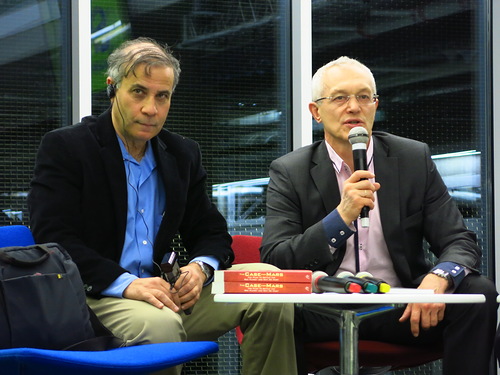
Robert Zubrin (Mars Direct) and Sergey Zhukov (cosmonaut, head of the Skolkovo space cluster)
')
October 21, 2013 in Moscow, at a meeting of the Friends Club of the Skolkovo Foundation space cluster, a meeting was held with Robert Zubrin.
Robert Zubrin - American aerospace engineer and author of books. Mars Direct Project Leader and Mars Society President
The owner of a number of patents in the field of aeronautics and astronautics.
In 2010, Zubrin, along with Karl Sagan , Brian Cox and Penelope Boston, were shown in the science video “The Case for Mars” as part of the Symphony of Science project.
Regalia: BA in Mathematics (1974), a MS in Nuclear Engineering (1984), a MS in Aeronautics and Astronautics (1986), and a Ph.D. in Nuclear Engineering (1992)
Zubrin : Good evening and thank you for the invitation. My report is called MarsDirect - Direct to Mars, manned flight to the Red Planet in 10 years.
Those of you who in the past were interested in the possibilities of flying to Mars have heard of huge space ships with enormous huge engines that will be built for this purpose in orbit. Such technologies and work of this scale are not feasible in the near future. But I do not think that such work is now necessary and expedient. My colleagues and I considered different options for space flight and different programs implemented earlier, successful and unsuccessful. And we thought, why is the flight to Mars so expensive. Of course, many developers want to sell their technology to fly to Mars. But we need to consider and select what is really appropriate.

To build a ship, of course, you need a launch vehicle that will bring all this into space. We and my colleagues tried to evaluate which components are necessary and sufficient for this. We concluded that four engines, two launch vehicles, and fuel and oxygen tanks, the same as used in the Saturn 5 project, are needed for a flight to Mars. There are different options for the location of the engines. Such a design could lift approximately 140 tons from the Earth’s surface and deliver about 47 tons of cargo to Mars — these calculations were carried out in accordance with a given carrying capacity. Until now, no one has delivered such a load into space and has not shipped it to another planet. We just launched cargo into near-earth space. And if you make this kind of calculation, you must take into account all the steps of this path.
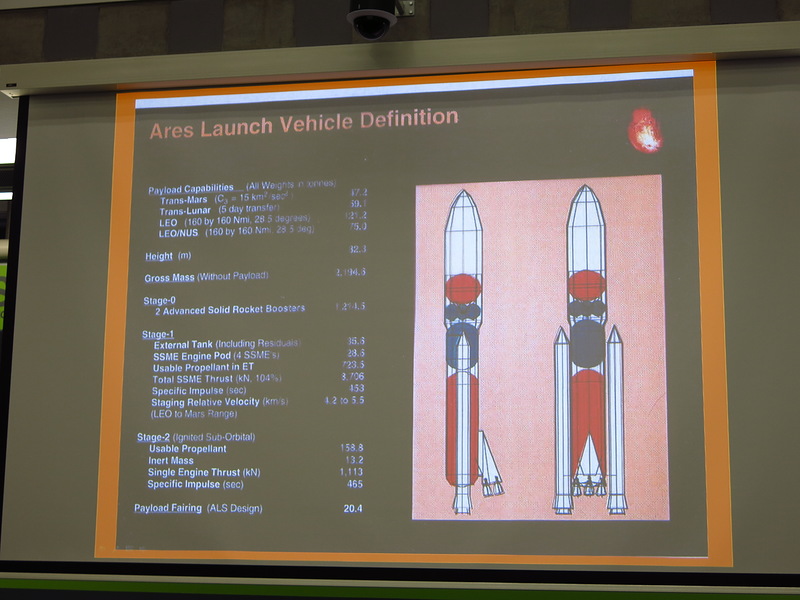
But if the mass of the ship and the mass of the cargo to be delivered to Mars are not tens, but hundreds of thousands of tons - will we be able to lift such a load from Cape Canaveral or from other cosmodromes? It is probably possible to divide the cargo into 8 parts, deliver them separately into orbit, assemble there and then deliver the cargo to Mars. Such projects have been proposed earlier, but have now been forgotten. The risk is too great - if at least one of the eight launches fails, the whole mission will fail. We are now developing a mission with just two launches and we are thinking that both launches will be successful. It is not necessary to use just such rockets, but the class must be of appropriate carrying capacity.
Why are the ships being developed in other missions so big? Most ships are calculated taking into account the fuel for the delivery of people to Mars and back. But here we can turn to the experience of travelers in the past. Did they always take with them everything to support themselves and the expedition, including feeding the horses, all the way? No, travelers tried to be self-sufficient and get everything they needed on the spot. Mars is a planet on which there are the necessary resources and which can become part of our technological chain. Why don't we travel light and to ease the carrying capacity of our mission, we will take the concept of self-reliance as a basis.
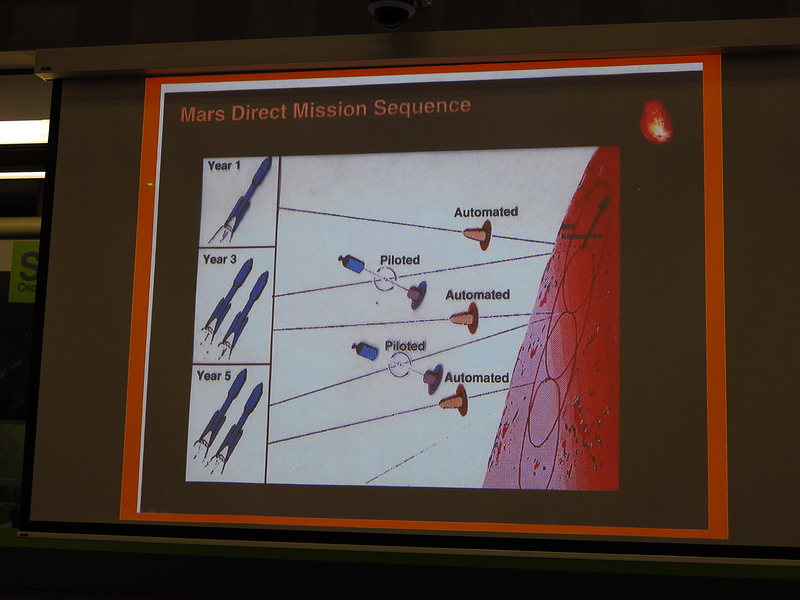
First we will send an unmanned rocket and 40 tons of cargo to Mars. The rocket will fly to Mars, slow down in the atmosphere of Mars, and we will drop the capsule onto the surface of Mars from the Mars orbit using a parachute, as we did in 1996 and put Curiosity last year. We will deliver the cargo, a capsule for the return flight from Mars, 5 meters in diameter, in which there are two decks, a compartment for the life support of the crew for 4 people. This capsule is designed for a flight from Mars to Earth in 6 months, and it will have empty fuel compartments.
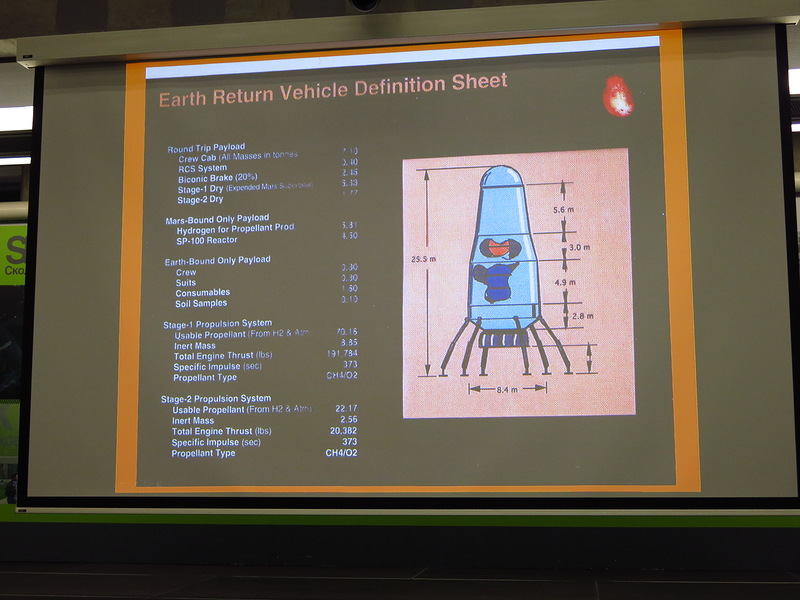
Why do we send compartments empty? Otherwise, the weight of our apparatus would increase significantly. In these compartments there will be 6 tons of hydrogen and a compartment with a small nuclear installation. After the rocket lands on Mars, a special robot will be able to deploy a nuclear power plant. When the power plant is installed in the crater or in the recess, we will be able to start it and with its help we will launch a chemical plant, which will produce carbon from the atmosphere and with the help of imported hydrogen we will get methane. This is a known exothermic Sabatier reaction, which does not require additional energy, and it passes with catalysts, which we can also pick up. As a result of this reaction, we get water and methane. From the water we get electrolysis of oxygen, which will become the fuel for the return trip, and we will collect the remaining hydrogen and store it in a special compartment. From carbon dioxide in the atmosphere of Mars, we also get oxygen, decomposing it into oxygen and carbon monoxide.

So we will significantly save on cargo, 18 times. We will not need to carry fuel to Mars. Thus, having brought only 6 tons of hydrogen, we will get more than one hundred tons or 95% of the fuel needed for the return trip. In addition, we will get enough fuel that will help us conduct research on Mars itself using rovers. We will produce enough fuel to bring the ship back to Earth and work on Mars. Chemical fuels have much greater efficiency, and engines work on such fuels much better. It may seem illogical to transport such amounts of fuel to Mars. But if you mine it right on Mars, the practical aspect of the project immediately increases. It makes no sense to fly to Mars, if there is no opportunity for research. And this production gives us a great product for such work.

Many experts in the field of astronautics consider this project as fiction. But this is not magic, it is a very simple technology. It is much simpler than launching a rocket into orbit. I proved this technology to NASA, we have proven that this principle works. Here is a model that we offer as a model for obtaining fuel for an engine that will send a capsule back to Earth. 8 months for the delivery of the capsule to Mars, and 10 months will be produced fuel. And already long before the new flight, we will know that Mars already has a rocket and there is fuel that the crew will be able to deliver back to Earth. And if we know that it did not succeed, then we will not launch the third stage. In two years we will launch two missiles - a manned vehicle and an unmanned vehicle. And since we already have a reverse rocket, we do not need to use a huge heavy machine. We will be able to use a “tin can”, 8 meters in diameter and 6 meters high.

The astronauts live on the upper deck, and loads are located on the first 'floor. There is a gym, library, laboratory, bedrooms and in the center - a refuge from solar radiation.

Two types of radiation can harm the crew. Solar flares from the sun and cosmic rays. Solar flares go constantly, but large ones occur once or twice a year, and they occur unpredictably. The likelihood that an outbreak happens within 6 months is very high. Solar radiation is protons, and to slow them down, a layer of water 12 cm thick is enough. We can equip a section in the center of the ship where astronauts can hide from a solar flare for several hours and shield the shelter with a ship and its cargo. We do not fully know the nature of cosmic radiation. Its force is enormous, and the energy with which particles of cosmic radiation are charged is such that a layer of 12 cm will not be enough, and the force of radiation here can be great. But, however, according to our studies, we can estimate the risk of cancer as a result of such radiation within 1%, because by quantitative parameters, the dose of such radiation is not so great. The Earth’s magnetic field is too weak to effectively deflect high-energy cosmic rays, the ISS crew receive half the radiation dose only because on the one hand the planet itself blocks these rays. We measured the radiation that the astronauts received at the station, and they did not receive the dose leading to radiation sickness. The ISS is working continuously and continuously, and we were able to conduct research that we can apply to our Martian mission, and assume that it is not so dangerous.
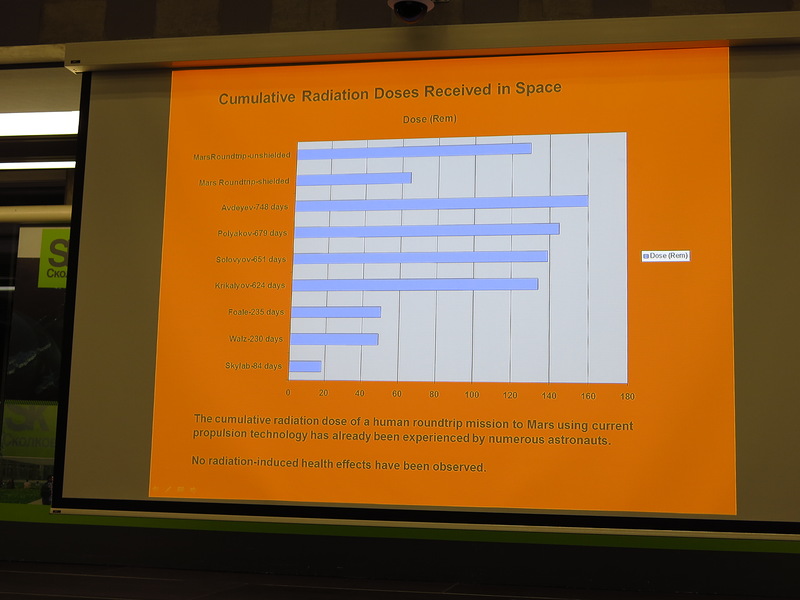
There are other risks that are dangerous for the crew, for example, zero gravity. Going into space implies some kind of physical activity. It is necessary to check the physical ability of the crew to perform such a flight. We conducted a test flight with an unmanned vehicle, we also created a simulator that is able to simulate gravity, which the crew will experience on Mars in order to assess how the changed conditions will affect the physical abilities of the crew. During the flight, we will connect the upper stage and the residential module with a 1500m cable to create artificial gravity. At a rotational speed of 1 revolution per minute, we will be able to provide gravity similar to that of Mars. At a speed of 2 revolutions per minute, we can reach Earth gravity. It will be necessary to provide medical solutions to this problem. The crew stay all the time at zero gravity is very risky.

We are considering options using the trajectory along which the ship can reach Mars in 6 months. Why did we choose such a trajectory? With this trajectory, the ship will be able to start returning to Earth 2 years after the crew’s start from Earth. At the same time, the conditions of flight efficiency are observed, since once every two years the relative position of the Earth and Mars is such that the flight takes place in the shortest possible time.
We also considered risk factors. First, we launch an unmanned vehicle that begins to produce fuel and conduct research using robotic vehicles. The piloted vehicle must arrive at the same point as the unmanned. What if the second unit drops to a point within a few hundred kilometers of the first? We have a rover on the first unmanned vehicle, which can deliver the unmanned aerial vehicle to our rocket. What if our ship lands much further than hundreds of kilometers? We will have a variant with a spare engine with which we will equip the manned vehicle, and it will be able to deliver the crew to the unmanned vehicle. And even if we are unable to find the first unmanned vehicle, if we fail to find the second unmanned vehicle, and the crew lands on Mars and is forced to adapt to life on Mars, the rocket will have everything necessary for life on Mars for three years. we can launch another unmanned vehicle. Assume that the second unmanned vehicle will land far from the rocket, anyway, we still have spare options with the first rover. So, in the fifth year, a second crew will land on Mars, which will bring another unmanned vehicle. Every two years, one manned and one unmanned spacecraft will be launched to Mars to provide ongoing exploration of Mars.
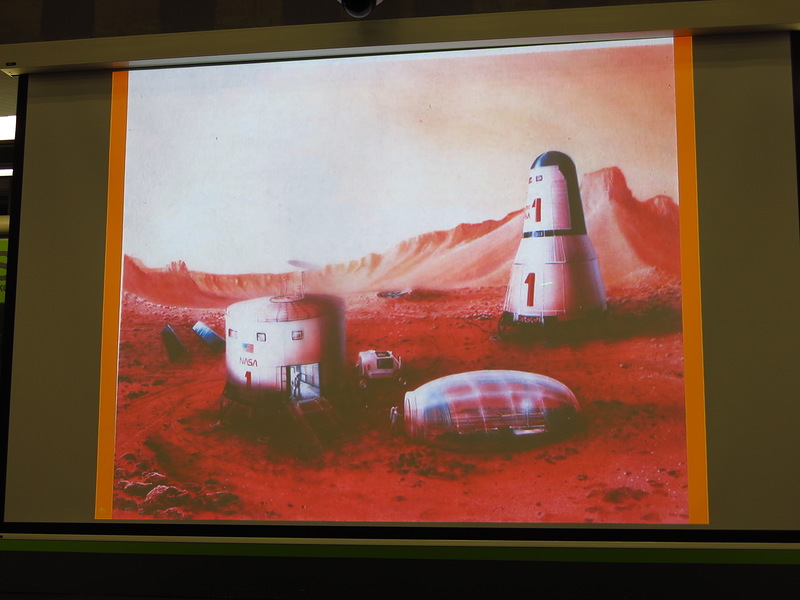
Let's see how the base looks on Mars. Here we see a capsule for the return journey to Mars, here are compartments for fuel. We see crew compartments, solar panels as backup power sources and additional backup power sources for a chemical plant. We are trying to develop the project in such a way as to maximize the use of Martian resources. The duration of the mission on Mars for the crew will be one and a half years, this period is determined by the relative position of the Earth and Mars, favorable for such a flight. I am in favor of planning the flight in such a way that the crew spend as much time as possible on Mars on research. It makes no sense to fly half a year and come back in a month. In a year and a half we will do a lot of research, and we will get fuel on Mars, and maybe we’ll finally answer the question - is there life on Mars?
We know that once there were rivers and oceans on Mars. There are numerous evidences confirming that there was water on Mars for billions of years, and this time is enough for life to arise. And if the concept of the emergence of life is chemically correct, then we can verify this. Such missions will allow us to fly to Mars, conduct research, prove or disprove the hypothesis of the origin of life by chemical means. We will be able to conduct experiments proving the possibility of life evolving from simple elements to complex compounds. If we can install oil rigs on Mars and reach the horizon of water inside Mars, then we can create a suitable habitat. And if we look at the history of life on Earth, then once upon a time conditions on Earth were similar to those that were on Mars. And perhaps life has been preserved in the depths of Mars, where there is water, or we can find traces of life in the past. All living beings use the same amino acids, and although there are some differences, there are common aspects of life, and maybe we will find something similar on Mars and say that these are common aspects for all organisms in space. Or we will find evidence that chemical evolution does not always lead to the emergence of life and that DNA cannot be formed exclusively by chemical means, and then the Earth’s experience is unique. But we can answer questions that have been worrying people for thousands of years. To do this, we need to get to Mars, drill the ground, reach the water and conduct these studies. And after a year and a half of research, we can go back to Earth.
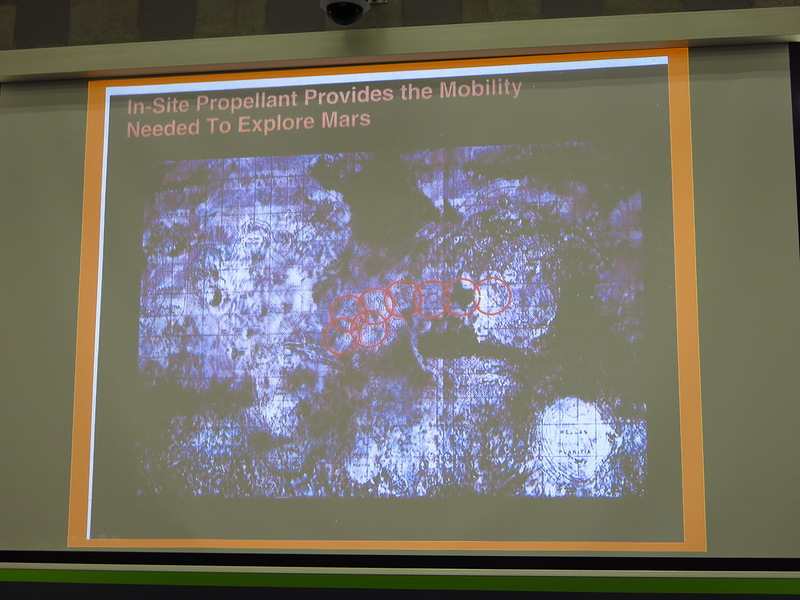
We will leave the greenhouse and residential compartments on Mars. This is advisable, since we will be able to use this equipment further, so as not to bring it again from Earth. This is a map of Mars. Many Americans might like to travel to Mars. We next placed a map of Texas to indicate the scale and drew a circle with a diameter of 800 km. It is not necessary to compare with Texas, it is comparable in size with France. These circles are at a distance of one day's journey, which the unmanned aerial vehicle can overcome. We indicate what area of Mars can be explored in the course of our missions. And we will answer the question - was there life on Mars and can there be life on Mars.
This is a planet whose land area corresponds to the area of the continents of the Earth. It has all the resources. If we can get to Mars, then maybe we can make Mars habitable - plant forests and inhabit them, as birds do. I believe it is possible. Life tends to transform the environment. Thus, the geosphere and biosphere appeared on Earth. Life penetrates everywhere where it can get. So life appeared in Hawaii, on the rocks far in the ocean. Birds brought seeds there, trees appeared, then people and cities appeared. If people fulfill the role of birds that will bring the seeds of life - then, of course, this life will not be the same as on Earth, and this will not happen in one generation.
What does habitat mean for us? I live in Colorado. Are the forests of Colorado habitable? There you can get lost, there you can not survive. But people specially trained can survive there. Survival depends on intelligence. If we learn to live on Mars, learn to grow plants and animals there, and produce materials, then we will be able to equip a region that will later liven up the whole of Mars. Here I would like to demonstrate that we can build bases of this type everywhere.

We need the following elements to create a base: launch vehicles, habitat modules, power plants, return flight capsules - these are the basic elements of equipment necessary for a mission. And these technologies are already at the disposal of modern scientists, and we can do this for 10 years, already with this generation.

, , . , , - , . , . , . , .

, , , . , , . , .

, .
. ( )
. . . . , — . . , . , . , , .
Question.An interesting lecture, everyone understands that technology is now at the level that a flight to Mars is possible. But the main question - there are two basic values in American and other history. Freedom and profit. With freedom here is understandable. Is it possible to make a profit from a flight to Mars - after all, it is profit that is the basis of capitalist history
Answer. , . , . , — . . — . . . . . . , . . — . — , , . — . . , . — . . , .
. . , , . 14 , , , . , ?
.There are also two issues here - technical and political. You are right, I designed the aircraft for a crew of two people, in this case we need three launches at each stage of the flight to Mars, I published an article about this and there is a book where I describe such technological solutions. I believe that in Russia it is necessary to develop your own variants of spacecraft, you have the technological and intellectual resources for this. But I do not think that Ilon Mask will want to develop such lethal devices for such a cost. We need political will, and we may need not hundreds, but tens of billions of dollars. This is not such a large share of budget expenditures on other sectors of the economy. And I think that ultimately we will have to attract state funds for the implementation of such a project.
Question. There are contradictions in your text. On the one hand, you say that the main task is to spread life on Mars, but on the other hand, these people are coming back. But the pilgrims were not going to return to Europe. And who is now the real driver of this project - NASA and other state-owned companies or Ilon Musk and other private companies?
Answer. . , - , , , . — , , . . , -. , — . , . — , . , , SpaceX , , . , .
, .
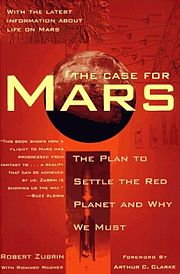
( PDF ) NASA
" In the American history, the pilgrims who came to Massachusetts played an important role. In their honor, we celebrate Thanksgiving every year. In the book of Governor of Massachusetts William Bradford, he wrote a book about pilgrims that once did not suit them in the outside world, and they decided to move to deserted places. Many responded to this call, many were frightened and resisted this idea. And we can conclude that great and venerable actions are always accompanied by tremendous difficulties. This book describes the process of a persuasion helped to create an enclave of civilization in the Americas. "

Robert Zubrin (Mars Direct) and Sergey Zhukov (cosmonaut, head of the Skolkovo space cluster)
')
October 21, 2013 in Moscow, at a meeting of the Friends Club of the Skolkovo Foundation space cluster, a meeting was held with Robert Zubrin.
Robert Zubrin - American aerospace engineer and author of books. Mars Direct Project Leader and Mars Society President
The owner of a number of patents in the field of aeronautics and astronautics.
In 2010, Zubrin, along with Karl Sagan , Brian Cox and Penelope Boston, were shown in the science video “The Case for Mars” as part of the Symphony of Science project.
Regalia: BA in Mathematics (1974), a MS in Nuclear Engineering (1984), a MS in Aeronautics and Astronautics (1986), and a Ph.D. in Nuclear Engineering (1992)
Zubrin : Good evening and thank you for the invitation. My report is called MarsDirect - Direct to Mars, manned flight to the Red Planet in 10 years.
Those of you who in the past were interested in the possibilities of flying to Mars have heard of huge space ships with enormous huge engines that will be built for this purpose in orbit. Such technologies and work of this scale are not feasible in the near future. But I do not think that such work is now necessary and expedient. My colleagues and I considered different options for space flight and different programs implemented earlier, successful and unsuccessful. And we thought, why is the flight to Mars so expensive. Of course, many developers want to sell their technology to fly to Mars. But we need to consider and select what is really appropriate.

To build a ship, of course, you need a launch vehicle that will bring all this into space. We and my colleagues tried to evaluate which components are necessary and sufficient for this. We concluded that four engines, two launch vehicles, and fuel and oxygen tanks, the same as used in the Saturn 5 project, are needed for a flight to Mars. There are different options for the location of the engines. Such a design could lift approximately 140 tons from the Earth’s surface and deliver about 47 tons of cargo to Mars — these calculations were carried out in accordance with a given carrying capacity. Until now, no one has delivered such a load into space and has not shipped it to another planet. We just launched cargo into near-earth space. And if you make this kind of calculation, you must take into account all the steps of this path.

But if the mass of the ship and the mass of the cargo to be delivered to Mars are not tens, but hundreds of thousands of tons - will we be able to lift such a load from Cape Canaveral or from other cosmodromes? It is probably possible to divide the cargo into 8 parts, deliver them separately into orbit, assemble there and then deliver the cargo to Mars. Such projects have been proposed earlier, but have now been forgotten. The risk is too great - if at least one of the eight launches fails, the whole mission will fail. We are now developing a mission with just two launches and we are thinking that both launches will be successful. It is not necessary to use just such rockets, but the class must be of appropriate carrying capacity.
Why are the ships being developed in other missions so big? Most ships are calculated taking into account the fuel for the delivery of people to Mars and back. But here we can turn to the experience of travelers in the past. Did they always take with them everything to support themselves and the expedition, including feeding the horses, all the way? No, travelers tried to be self-sufficient and get everything they needed on the spot. Mars is a planet on which there are the necessary resources and which can become part of our technological chain. Why don't we travel light and to ease the carrying capacity of our mission, we will take the concept of self-reliance as a basis.

First we will send an unmanned rocket and 40 tons of cargo to Mars. The rocket will fly to Mars, slow down in the atmosphere of Mars, and we will drop the capsule onto the surface of Mars from the Mars orbit using a parachute, as we did in 1996 and put Curiosity last year. We will deliver the cargo, a capsule for the return flight from Mars, 5 meters in diameter, in which there are two decks, a compartment for the life support of the crew for 4 people. This capsule is designed for a flight from Mars to Earth in 6 months, and it will have empty fuel compartments.

Why do we send compartments empty? Otherwise, the weight of our apparatus would increase significantly. In these compartments there will be 6 tons of hydrogen and a compartment with a small nuclear installation. After the rocket lands on Mars, a special robot will be able to deploy a nuclear power plant. When the power plant is installed in the crater or in the recess, we will be able to start it and with its help we will launch a chemical plant, which will produce carbon from the atmosphere and with the help of imported hydrogen we will get methane. This is a known exothermic Sabatier reaction, which does not require additional energy, and it passes with catalysts, which we can also pick up. As a result of this reaction, we get water and methane. From the water we get electrolysis of oxygen, which will become the fuel for the return trip, and we will collect the remaining hydrogen and store it in a special compartment. From carbon dioxide in the atmosphere of Mars, we also get oxygen, decomposing it into oxygen and carbon monoxide.

So we will significantly save on cargo, 18 times. We will not need to carry fuel to Mars. Thus, having brought only 6 tons of hydrogen, we will get more than one hundred tons or 95% of the fuel needed for the return trip. In addition, we will get enough fuel that will help us conduct research on Mars itself using rovers. We will produce enough fuel to bring the ship back to Earth and work on Mars. Chemical fuels have much greater efficiency, and engines work on such fuels much better. It may seem illogical to transport such amounts of fuel to Mars. But if you mine it right on Mars, the practical aspect of the project immediately increases. It makes no sense to fly to Mars, if there is no opportunity for research. And this production gives us a great product for such work.

Many experts in the field of astronautics consider this project as fiction. But this is not magic, it is a very simple technology. It is much simpler than launching a rocket into orbit. I proved this technology to NASA, we have proven that this principle works. Here is a model that we offer as a model for obtaining fuel for an engine that will send a capsule back to Earth. 8 months for the delivery of the capsule to Mars, and 10 months will be produced fuel. And already long before the new flight, we will know that Mars already has a rocket and there is fuel that the crew will be able to deliver back to Earth. And if we know that it did not succeed, then we will not launch the third stage. In two years we will launch two missiles - a manned vehicle and an unmanned vehicle. And since we already have a reverse rocket, we do not need to use a huge heavy machine. We will be able to use a “tin can”, 8 meters in diameter and 6 meters high.

The astronauts live on the upper deck, and loads are located on the first 'floor. There is a gym, library, laboratory, bedrooms and in the center - a refuge from solar radiation.

Two types of radiation can harm the crew. Solar flares from the sun and cosmic rays. Solar flares go constantly, but large ones occur once or twice a year, and they occur unpredictably. The likelihood that an outbreak happens within 6 months is very high. Solar radiation is protons, and to slow them down, a layer of water 12 cm thick is enough. We can equip a section in the center of the ship where astronauts can hide from a solar flare for several hours and shield the shelter with a ship and its cargo. We do not fully know the nature of cosmic radiation. Its force is enormous, and the energy with which particles of cosmic radiation are charged is such that a layer of 12 cm will not be enough, and the force of radiation here can be great. But, however, according to our studies, we can estimate the risk of cancer as a result of such radiation within 1%, because by quantitative parameters, the dose of such radiation is not so great. The Earth’s magnetic field is too weak to effectively deflect high-energy cosmic rays, the ISS crew receive half the radiation dose only because on the one hand the planet itself blocks these rays. We measured the radiation that the astronauts received at the station, and they did not receive the dose leading to radiation sickness. The ISS is working continuously and continuously, and we were able to conduct research that we can apply to our Martian mission, and assume that it is not so dangerous.

There are other risks that are dangerous for the crew, for example, zero gravity. Going into space implies some kind of physical activity. It is necessary to check the physical ability of the crew to perform such a flight. We conducted a test flight with an unmanned vehicle, we also created a simulator that is able to simulate gravity, which the crew will experience on Mars in order to assess how the changed conditions will affect the physical abilities of the crew. During the flight, we will connect the upper stage and the residential module with a 1500m cable to create artificial gravity. At a rotational speed of 1 revolution per minute, we will be able to provide gravity similar to that of Mars. At a speed of 2 revolutions per minute, we can reach Earth gravity. It will be necessary to provide medical solutions to this problem. The crew stay all the time at zero gravity is very risky.

We are considering options using the trajectory along which the ship can reach Mars in 6 months. Why did we choose such a trajectory? With this trajectory, the ship will be able to start returning to Earth 2 years after the crew’s start from Earth. At the same time, the conditions of flight efficiency are observed, since once every two years the relative position of the Earth and Mars is such that the flight takes place in the shortest possible time.
We also considered risk factors. First, we launch an unmanned vehicle that begins to produce fuel and conduct research using robotic vehicles. The piloted vehicle must arrive at the same point as the unmanned. What if the second unit drops to a point within a few hundred kilometers of the first? We have a rover on the first unmanned vehicle, which can deliver the unmanned aerial vehicle to our rocket. What if our ship lands much further than hundreds of kilometers? We will have a variant with a spare engine with which we will equip the manned vehicle, and it will be able to deliver the crew to the unmanned vehicle. And even if we are unable to find the first unmanned vehicle, if we fail to find the second unmanned vehicle, and the crew lands on Mars and is forced to adapt to life on Mars, the rocket will have everything necessary for life on Mars for three years. we can launch another unmanned vehicle. Assume that the second unmanned vehicle will land far from the rocket, anyway, we still have spare options with the first rover. So, in the fifth year, a second crew will land on Mars, which will bring another unmanned vehicle. Every two years, one manned and one unmanned spacecraft will be launched to Mars to provide ongoing exploration of Mars.

Let's see how the base looks on Mars. Here we see a capsule for the return journey to Mars, here are compartments for fuel. We see crew compartments, solar panels as backup power sources and additional backup power sources for a chemical plant. We are trying to develop the project in such a way as to maximize the use of Martian resources. The duration of the mission on Mars for the crew will be one and a half years, this period is determined by the relative position of the Earth and Mars, favorable for such a flight. I am in favor of planning the flight in such a way that the crew spend as much time as possible on Mars on research. It makes no sense to fly half a year and come back in a month. In a year and a half we will do a lot of research, and we will get fuel on Mars, and maybe we’ll finally answer the question - is there life on Mars?
We know that once there were rivers and oceans on Mars. There are numerous evidences confirming that there was water on Mars for billions of years, and this time is enough for life to arise. And if the concept of the emergence of life is chemically correct, then we can verify this. Such missions will allow us to fly to Mars, conduct research, prove or disprove the hypothesis of the origin of life by chemical means. We will be able to conduct experiments proving the possibility of life evolving from simple elements to complex compounds. If we can install oil rigs on Mars and reach the horizon of water inside Mars, then we can create a suitable habitat. And if we look at the history of life on Earth, then once upon a time conditions on Earth were similar to those that were on Mars. And perhaps life has been preserved in the depths of Mars, where there is water, or we can find traces of life in the past. All living beings use the same amino acids, and although there are some differences, there are common aspects of life, and maybe we will find something similar on Mars and say that these are common aspects for all organisms in space. Or we will find evidence that chemical evolution does not always lead to the emergence of life and that DNA cannot be formed exclusively by chemical means, and then the Earth’s experience is unique. But we can answer questions that have been worrying people for thousands of years. To do this, we need to get to Mars, drill the ground, reach the water and conduct these studies. And after a year and a half of research, we can go back to Earth.

We will leave the greenhouse and residential compartments on Mars. This is advisable, since we will be able to use this equipment further, so as not to bring it again from Earth. This is a map of Mars. Many Americans might like to travel to Mars. We next placed a map of Texas to indicate the scale and drew a circle with a diameter of 800 km. It is not necessary to compare with Texas, it is comparable in size with France. These circles are at a distance of one day's journey, which the unmanned aerial vehicle can overcome. We indicate what area of Mars can be explored in the course of our missions. And we will answer the question - was there life on Mars and can there be life on Mars.
This is a planet whose land area corresponds to the area of the continents of the Earth. It has all the resources. If we can get to Mars, then maybe we can make Mars habitable - plant forests and inhabit them, as birds do. I believe it is possible. Life tends to transform the environment. Thus, the geosphere and biosphere appeared on Earth. Life penetrates everywhere where it can get. So life appeared in Hawaii, on the rocks far in the ocean. Birds brought seeds there, trees appeared, then people and cities appeared. If people fulfill the role of birds that will bring the seeds of life - then, of course, this life will not be the same as on Earth, and this will not happen in one generation.
What does habitat mean for us? I live in Colorado. Are the forests of Colorado habitable? There you can get lost, there you can not survive. But people specially trained can survive there. Survival depends on intelligence. If we learn to live on Mars, learn to grow plants and animals there, and produce materials, then we will be able to equip a region that will later liven up the whole of Mars. Here I would like to demonstrate that we can build bases of this type everywhere.

We need the following elements to create a base: launch vehicles, habitat modules, power plants, return flight capsules - these are the basic elements of equipment necessary for a mission. And these technologies are already at the disposal of modern scientists, and we can do this for 10 years, already with this generation.

, , . , , - , . , . , . , .

, , , . , , . , .

, .
. ( )
. . . . , — . . , . , . , , .
Question.An interesting lecture, everyone understands that technology is now at the level that a flight to Mars is possible. But the main question - there are two basic values in American and other history. Freedom and profit. With freedom here is understandable. Is it possible to make a profit from a flight to Mars - after all, it is profit that is the basis of capitalist history
Answer. , . , . , — . . — . . . . . . , . . — . — , , . — . . , . — . . , .
. . , , . 14 , , , . , ?
.There are also two issues here - technical and political. You are right, I designed the aircraft for a crew of two people, in this case we need three launches at each stage of the flight to Mars, I published an article about this and there is a book where I describe such technological solutions. I believe that in Russia it is necessary to develop your own variants of spacecraft, you have the technological and intellectual resources for this. But I do not think that Ilon Mask will want to develop such lethal devices for such a cost. We need political will, and we may need not hundreds, but tens of billions of dollars. This is not such a large share of budget expenditures on other sectors of the economy. And I think that ultimately we will have to attract state funds for the implementation of such a project.
Question. There are contradictions in your text. On the one hand, you say that the main task is to spread life on Mars, but on the other hand, these people are coming back. But the pilgrims were not going to return to Europe. And who is now the real driver of this project - NASA and other state-owned companies or Ilon Musk and other private companies?
Answer. . , - , , , . — , , . . , -. , — . , . — , . , , SpaceX , , . , .
, .

( PDF ) NASA
Source: https://habr.com/ru/post/204730/
All Articles